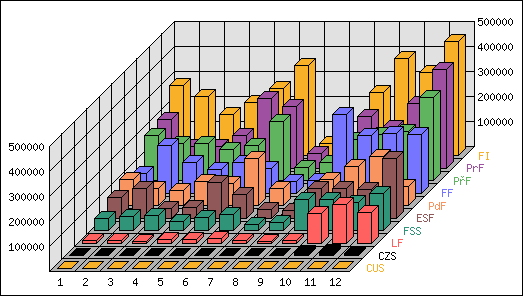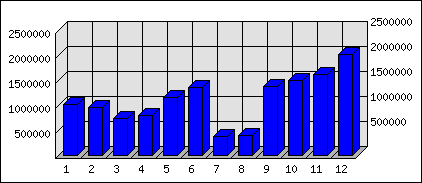
Information
Technology Centre
Head:
Ing. Michal Brandejs
Botanická
68a, 602 00 Brno
phone: ++420–5–41 512 322
In
its second year of operation, the development of the MU information system (is.muni.cz)
continued mainly in the direction of new application packages and responses to
the users’ requests. We succeeded in implementing the system in a number of
the school's administrative procedures, and in accessing wider academic
public. As of December 31, 2000, the information system had 14,177 users who
regularly worked with the system and 18,113 users who logged on to the system
occasionally. Soon after the start of the school year, it became obvious that
a limiting factor of further development of the system is the growth in demand
on the server became and the consequent slow-down of the system response that
exceeded the acceptable level. Therefore, the original configuration (Sun
Microsystems Ultra 450 server with 4 processors, 2 GB of real storage and 32
GB of disc memory) was expanded by a set of PC platform configured computers
which distributed user demand. We believe that this technology will be
sufficient for the operation of the system in 2001.
General
information
Number of log-ins in 2000: 14,493,632
Maximum server response rate: 15,482 requests per hour
Number of scripts (individual programmes) of the systems:
482
Number
of registered data types: approx. 1620 (in 295 database tables and approx. 40
categories)
Number of publication records: 23,000 (of which 18,318 for
the national Research and Development Information Register)
Number of queries answered at the contact address: approx.
1300
Length of time for which the server was not accessible: 26
hours (23 hours of scheduled shut-downs and 3 hours breakdowns)
List of Important Applications
Implemented in 2000
Because a number of applications are accessed by different
groups of users from different access points and with different access rights
(e.g. for viewing or editing); the following classification into categories is
only auxiliary. Only those applications that were produced completely or for
the most part in 2000 are listed (for the total summary see the 1999 Annual
Report).
Catalogue
of courses:
formatted
course data, bulk printout option
complete
course listing and acquisition of data accuracy confirmations
bulk
processing of all basic data on a course
bulk
processing of teachers' data
survey
of changes in the Catalogue of courses
survey
of planned system loads
surveys
of optional attribute use in external courses/faculties
Administration
of seminar groups:
definition,
adjustments and administration of courses for division into smaller groups
lists
and surveys of seminar groups
export
and import of seminar groups
capacity
limits sharing among seminar groups
Teacher’s notes:
creation,
editing, administration and validation of notepads (teacher-defined
administration of information on students and their work, etc.)
processing
student information on notepads
distributing
and publishing the contents of the blocks
block
summaries for point evaluations, point evaluations, transfer of
evaluations
statistics,
graphs, notepad printouts
evaluation
statistics and average evaluation of courses
transfer
of students among seminar groups
history
of log-ins to seminar groups
list
of problematic course registrations, student cancellation requests
notepad
configurations: other selections/ student restrictions
My course of study:
enrolment
in and withdrawal from seminar groups
information
from notepad blocks
grades
for the whole study programme, credits obtained and grade averages
publication
of study programme results
student
data history
Personnel Agenda:
list
of work positions
printouts
of defined groups of persons
lists
of workplaces
pages
of workplaces, lists of their staff
Study
register
tuition
fees and courses at Czech schools of higher education
list
of tuition fees, register of fees
proposed
list of disciplines where tuition fees are to be charged
bulk
updates (titles, study groups, completion of term)
recognition
and transfer of courses among study programmes
register
of students’ final tests
registration
and enrolment text and graphic print-outs
printing
of certificates, survey of grades (text and graphic print-outs)
printing
of Final Exam Reports
printing
of diplomas, final certificates
printing
of replacement Student ID Cards
registration
of annual extensions of ISIC cards
cancellation
and renewal of chip cards
application
for ISIC cards, queue of print applications
statistics
of ISIC cards printed
mailings
of notices to teachers about inadequately completed evaluation forms
record
of grades
history
of changes in registration and enrolment
imports
of students from entrance exams
list
of long-term running applications
new
types of search queries
number
of current responses of requests to deans' offices and upgrades of current
applications
New versions of programmes for the administration
of publication activities and for structured CVs have been developed in
response to users' requests and according to new programming standards. They
offer the same (slightly expanded) functionality as last year in a more user-friendly
formats, i.e. a record of one’s own or someone else’s CV, printouts,
exports, publications, lists and CV searches). Registration of publication
activities also includes searching applications, acquisition and checking of
data for Research and development Information Register, and full list of one’s
(or otherwise important) publication and their publication histories.
Contacts and Presentations:
basic
and detailed register of buildings
register
of contact addresses to people
register
of contact addresses to offices
viewing,
creating and printing of telephone and other directories
requests
for data changes, resolving queries
documentation
server (notice board groups for internal and public documents)
general
Notice Board (a possibility for anyone to address a particular segment of
the university community)
Other
administration software packages
passes
and chip cards: cancellation and renewal
access
points administration
permission
and temporary blocking of access
registration
of passage through permitted access points
user
design of IS pages: selection, creation and modification
The above-mentioned sets of applications have made the MU IS a comprehensive tool that is useful at all levels of the academic community. Currently MU IS administration software packages cover all the basic spheres of school administration in the field of study, with overlaps into other areas. In 2001, administrative tools developed on users' requests (e.g. system for student projects and papers, means for the internal evaluation of faculties, timetable registration) are to be implemented.
The
impact of the Information System on the organisation
The
fact that the use of the information system is not limited to appointed staff
only but has become a tool used by the academic community at large is
considered a significant success in its development and operation. This helps
us to fulfil some of the aims set for the IS in its development: e.g., the
registration and presentation of objective and verified data, support of inter-faculty
approach to study, significant improvement of MU personnel and student
computer literacy, smoother and easier communication and co-operation within
each faculty and amongst the faculties, appropriate presentation of
information on the details of the study to non-university parties and those
interested in study.
It
is only natural that some software packages are used more frequently than
others.
How
the system is generally used
In
2000, the system was used at least once by 18,113 registered users, and over
14,177 people logged-in over 100 times (MU has approximately 20,000 students
in various types of courses and about 3,000 employees.) Six hundred and
fourteen people listed a reference to their home web pages outside the MU IS
on their People at MU web page, and 616 people can be searched for under
key words. A total of 9,219 people read messages on the Notice Board;
4,413 people verified their registered personal data throughout the year 2000.
Science
and Publishing Activities
The
system's database of publications includes 266,681 records of which 23,147
were modified or entered by the system users. There are 1539 people who
personally work with the data (the remaining records are entered by authorised
personnel, mostly the secretaries). At least 747 CVs worked on by 529 people
have been entered into the system. A total of 4315 people looked at a
minimum of one CV.
Data
quality in the Catalogue of Course
In
the spring 2000 term, the system registered 5,685 courses taught by 1791
teachers, and 5,776 courses taught by 1909 teachers in the autumn 2000
term. In the two terms, 2258 and 3304 courses used English annotation or
syllabus, respectively.
Recommended
literature is listed for a total of 3409 courses (in total this represents
5080 titles). There are 543 and 775 subjects in which teachers give additional
information, including instructions and advice for students, i.e. data
provided by teachers in addition to obligatory data. Basic information on
subjects (titles, number of credits) is administered by approximately 200
people at MU.
Use
of the Teacher’s notes
Teacher’s
notes is a key administration software package for users whose positive
approach to the IS can provide a wide range of services for the largest
university target group, i.e. the students. If the teachers use the IS, we can
expect improvement in the development of e-mail communication, the quicker
publication of grades, recommended literature and additional materials. The
availability of powerful tools for teachers who have mastered IT and
simplification of the basic administrative software for teachers have resulted
in a great percentage of teachers who use the system.
In
2000, 1022 teachers personally entered grades into the IS. Students can
electronically register for exams in the case of a total of 906 courses (a
feature greatly appreciated by students). This agenda is mostly used at the
Faculty of Science, followed by the Faculty of Arts, the Faculty of Economics
and Administration, Faculty of Informatics and the Faculty of Law. Notepads (suitable
mainly for the ongoing registration of the study programme during the semester,
and subsequent administrative procedures) is not commonly used; it is used by
only 81 teachers.
Inter-faculty
programmes of study
The
simplification administration of students who want to enrol in additional
subjects from external faculties and include them as a part of their studies
is one of our many ongoing goals. In 2000, there were 1659 applications for
courses in external disciplines (the real enrolment numbers are, however,
lower). Students can also make a request for an exception if they are formally
not entitled to enrol in a course but have a justifiable interest in the
external course, either within their faculty or externally. A total of 494 of
such requests were not granted.
Conclusion
Experience
from the second year of the existence and operation of MU IS shows that thanks
to the wide range of services, a large portion of the university community has
been involved. We succeeded in overcoming concerns that there will be a
shortage of IT equipment or that working with the Internet is too
intellectually demanding. It seems that the users have got to like the system
and are quite able to use it.
Similarly, the
applied concept of co-operation with the users and our (as quick as possible)
responses to their requests have proved to be mutually beneficial, and
gradually a new class of users came into being at the faculties who are able
to perceive the system, more or less, as a whole and whose comments and ideas
are extremely valuable.
Thanks
to the optimisation of the whole system, we managed to solve the biggest
problem so far – the slow system response time during busy periods.
Currently (at the end of 2000), about 4000 people work with IS daily and
smoothly, even at peak hours. The users carry out up to 165,000 operations a
day. No operations that can be performed at MU at the end of 2000 are capable
of overloading the system.
The
use of MU Information System in 2000
The
horizontal axis shows months, and the vertical axis shows the number of opened
pages in a particular month (is.muni.cz). Only cases of authorised access listed
in individual faculties are displayed.

The
total number of authorised accesses in individual months:
